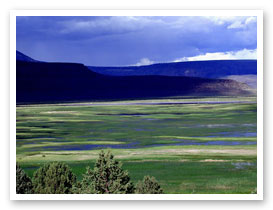 INSTITUTE FOR NATURAL RESOURCES
INSTITUTE FOR NATURAL RESOURCESYou are here
Ecosystem Services
- Intro
- Planning Resources
- Research Projects
- Articles & Stories
- Maps & Tools
- Reports & Publications
- Data
- Photos & Videos
- More
Wetland Ecological Services
Wetland services and functions are the wide array of ecological and physical processes that create and maintain wetlands and influence the landscape surrounding them. These services include animal and plant habitat, chemical transformation, sediment trapping, floodwater retention, and water quality.
Wetlands ...
Create Habitat. Wetlands create rich habitat for thousands of species of microbes, plants, invertebrates, amphibians, reptiles, birds, fish, and mammals. Here in Oregon, a great diversity of wetland types occur across the state. Within these areas, a multitude of species find the perfect conditions for rest, food and the raising of new generations. From estuaries of the Columbia River where young salmon seek shelter, to marshes of the Klamath Basin where migratory birds swoop down for their stopovers, wetlands are vital habitats for Oregon wildlife.

Crump Lake in Warner Valley:
Photo by Bruce Taylor
Store and Release Water. Like sponges, wetlands absorb, store, and release water. They provide a buffer against flooding by absorbing and retaining high water levels. Besides acting as a buffer system against flooding, wetlands regulate water flows through watershed systems. During storm events, wetlands can desynchronize the timing with which surges from a storm event enter a main stem from different tributaries. Water stored in wetlands help maintain base streamflow during dry periods and also release water to the groundwater system, facilitating recharge.
Improve Water Quality. Wetlands slow water down so that sediments, pollutants, nutrients and pathogens drop out of the water column. These precipitates usually remain in the wetland, allowing the filtered water to enter streams, lakes, rivers, estuaries and groundwater. This filtration function is the reason that wetlands are referred to as nature kidneys. Some precipitates like nitrogen and phosphorus are used by wetland plants and animals or converted chemically by soil organisms to other compounds, while others simply accumulate in sediments or are flushed out later.
Reduce Erosion. Storage and filtration of water by wetlands reduces downstream erosion and sedimentation, protecting both the natural and man-made environment. Wetlands also absorb the destructive force of waves and currents, protecting coastal and riparian areas. The roots of wetland plants stabilize soil and keep it from being washing away.
Increase Biological Productivity and Diversity. Like coral reefs and rainforests, wetlands are efficient natural factories that turn sunlight into biomass at a rapid rate. This biological productivity provides the base for complex food chains and habitats, and accounts for the great diversity of life in wetlands. This abundance of life helps the wetland reduce erosion, feed wildlife, and fill our plates.










